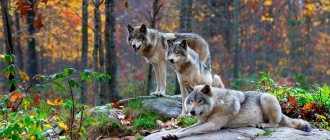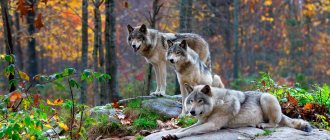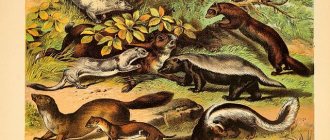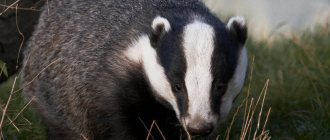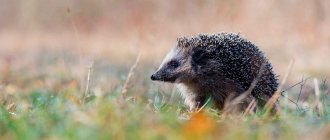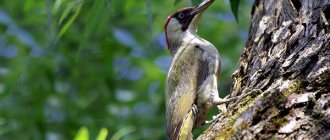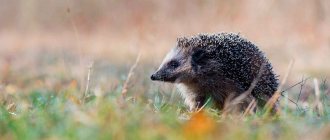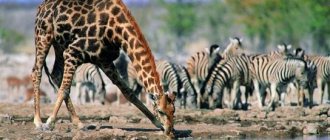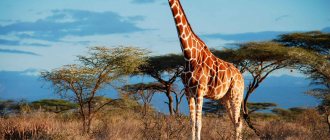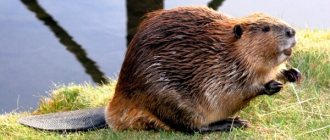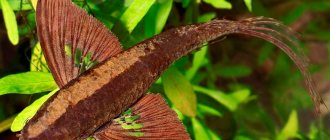The badger, a member of the weasel family, has a very recognizable appearance, making it very difficult to confuse it with any other animal. But seeing a badger is not an easy task. And all because this animal is nocturnal and prefers to spend all daylight hours in its hole, and in the winter the badger completely hibernates! The badger population today is assessed as stable, and the benefits and harms of the animal for humans are very difficult to unambiguously assess.
Description of the badger
The length of an adult badger reaches from 60 to 90 cm, the length of its tail is 20-24 cm, its weight is up to 24 kg, and before the hibernation period it increases to 34 kg.
The body is massive, of a peculiar shape, which resembles a wedge directed forward, with a sharply narrowed, elongated thin muzzle. The neck is very short, it is almost invisible. The limbs are also short and large. The fingers end in long, blunt claws, well suited for digging. — Advertising —
A badger's fur is coarse. The back and sides are brownish-gray with a silvery tint, the underside of the body is blackish. The muzzle is decorated with two dark stripes that stretch from the nose to the ears.
Origin of the species and description
Photo: Badger
As already mentioned, the badger is a representative of the mustelid family; it belongs to mammals from the badger genus. Mustelids or martens represent a group of predators. This family has a fairly large assortment of different species - more than fifty. So it includes: ferret, otter, mink, wolverine, marten and, naturally, badger. They adapt perfectly to different living conditions, so they are found in almost all corners of the globe.
For predators they are quite small; there are also very small ones. The length of the body varies from 11 cm (weasel) to one and a half meters (sea otter). The body is usually graceful and elongated, although there are also massive representatives (wolverine and badger).
As for badgers specifically, there are several types of them:
- Asian badger;
- Japanese badger;
- European badger (common);
- American badger.
All of them differ from each other not only in their habitat, but in the color of their fur, some habits and external features. The common badger (European) has a permanent residence permit in Russia, whose attractive appearance is well known to many.
Badger nutritional features
Badgers are omnivores, but their diet is dominated by animal food. These are mouse-like rodents, frogs, lizards, birds and their eggs, insects and their larvae, mollusks, earthworms, in addition, badgers eat mushrooms, berries, nuts and grass. When hunting, a badger goes around a fairly wide area, searches through fallen trees, tears off the bark of trees and stumps, under which insects and worms hide. During one hunt, an adult badger manages to collect from 50 to 70 frogs, hundreds of insects and worms. He needs about 500 g of food per day; he eats more only before hibernation, when he eats up and gains fat, a future source of nutrition for the whole winter.
Appearance
The head of a badger is elongated, with medium-sized eyes and short, rounded ears . At the caudal base there are anal glands, designed to secrete a pungent odorous liquid. The secreted odorous substance allows animals not only to recognize their relatives, but also to some extent to communicate with each other. The animal has short and strong legs with strong and slightly curved claws, adapted for tearing the ground. The sole on the paws of the animal is of a characteristic hairless type. Using the flattened chewing surfaces of the back molars, the animal grinds any plant food.
The body area and tail are covered with coarse, bristly and fairly long guard hairs. The presence of a shorter and thinner undercoat is also noted. The fur on the head and paws is noticeably shorter. Badgers are characterized by slow molting, which occurs throughout the summer. In the last ten days of spring, loss of undercoat is observed, and at the beginning of summer the animal actively loses guard hair. Animals' old fur falls out closer to autumn, and at the same time a gradual growth of new hair is noted.
- 36 facts about elephants
- Rodents
- 35 facts about foxes
- Animals of Brazil
- Tarantula spider
- 34 facts about lions
This is interesting! The male badger is larger than the female, and the body length of an adult animal varies between 60-90 cm, with a tail length of 20-24 cm and an average body weight of no more than 23-24 kg. The weight of a badger before hibernation can reach 33-34 kg.
The color varies depending on the characteristics of the region, but the presence of grayish-brown fur on the back and dark fur along the entire ridge can be considered as general characteristics. As a rule, there are light “ripples” on the sides of the animal. In the head area there is a dark stripe that runs through the eyes from the badger's nose, covers the ears or touches the upper edges. The frontal part and cheeks have a characteristic whitish, yellowish or brown coloration. The color of the fur in summer is darker, with a reddish tint. Young individuals tend to have less bright and pronounced coloring.
Common badger subspecies
— Advertising —
For badgers, three subspecies are distinguished depending on their distribution areas:
- Meles meles meles – lives in Western Europe;
- Meles meles marianensis – inhabitant of Spain and Portugal;
- Meles meles leptorynchus - found in Russia.
Character and lifestyle
Badgers are nocturnal and live in small groups averaging 6 individuals, although groups of up to 23 animals have been observed. Group size varies depending on terrain and food supply. The group occupies an area ranging from 30 to 150 hectares. There is a strict hierarchy within the group - large males dominate over small ones, not giving the latter the opportunity to reproduce. Females can dominate other females, preventing subordinate females from reproducing and forcing them to help care for their own offspring.
During the mating season, badgers are characterized by fights for females and territory, and fights often end in serious injury or death. The rest of the time, the animals are quite peaceful towards each other. It is customary for animals within a group to groom each other—clean, lick, etc.
Badger burrows have a complex structure and are inherited. Several badger families usually live in one hole at the same time. The burrow can have up to 50 exits, from 35 to 81 meters of passages and several nesting areas. The passage dimensions are on average 22-63 cm wide, and up to 32 cm high. On average, the hole is located underground at a depth of 1.1 meters, but in some cases it goes to a depth of 2.3 meters.
Badgers are very clean animals and maintain order in their burrows. Inside, the animals line the hole with grass, straw, leaves and ferns, and the bedding is changed regularly. In winter, predators often take the litter out for ventilation and then bring it back. Animals never defecate in a hole, only in specially designated areas nearby. In case of extreme need, if they cannot get into the hole, badgers can live in haystacks in winter. The animals sometimes share a hole with foxes and rabbits.
Badger behavior
Badgers prefer to live in mixed and taiga forests, and occasionally in mountain forests; in the south they also live in steppes and semi-deserts.
They need dry, well-drained areas located near bodies of water or swampy lowlands where they can find plenty of food. Badgers live in deep burrows dug by them on the slopes of sandy hills, ravines and ravines in forests. They are very attached to the area in which they live, and can even pass on their burrows from generation to generation. The old badger fort is a complex multi-tiered underground structure with 40-50 openings for entry and ventilation, it has long (5-10 m) tunnels that lead to 2-3 large nesting chambers. The latter are placed under the protection of waterproof layers, at a depth of about 5 m, so that rain and groundwater do not seep into them, and are lined with dry bedding. Single individuals have simple burrows, equipped with one entrance and a nesting chamber. Badgers keep order in their burrows and clean them, regularly changing the bedding. Their burrows can be occupied by foxes and raccoon dogs.
Barskis are nocturnal, in the morning they can be observed until about 8 o'clock, in the evening - starting from 17-18. This is the only species among mustelids that hibernates during the winter. In the north, badger hibernation begins in October-November and lasts until March-April; in the south of the range, in the event of a mild winter, the animals remain active throughout the year.
Badgers are not aggressive towards predators or people and usually tend to hide in holes, but an angry badger will nudge and bite its attacker before running away.
general characteristics
Badger (Meles) This is a predatory mammal from the mustelidae family.
The badger received its official name in 1758. Swedish zoologist Carl Liney described the animals in The System of Nature and gave the predators the scientific name Meles meles. Adults can weigh between 20 and 25 kg. In the autumn, before hibernation, badgers gain at least 10 kg to their constant weight. Body length from 61 to 92 cm.
The body shape is cone-shaped, round. The legs are short and small compared to the body. The fingers have well-developed claws, with blunt tips, well adapted for digging. When moving, the badger rests on the ground with its entire foot at once.
The neck is massive and short. The head is small, extended towards the muzzle. The ears are semicircular and relatively small in size.
Recommended by topic
Fox Panda Lynx
The body, depending on the species, is covered with gray or light brown hair. Paws are black. On the head is a mask of contrasting colors. Usually black and white. Two vertical stripes stretch from the ears to the nose, and there is white fur around the eyes.
In males, near the tail there are anal glands that contain an odorous secretion. Animals use glands to mark their territory. But smells serve badgers to convey information. Animals can find out the gender, age, and sometimes the approximate size of an opponent.
Sexual dimorphism is weakly expressed. Males are slightly larger than females. The individuals have no external differences.
Life expectancy in the wild is from 10 to 12 years. In zoos and nature reserves, badgers can live much longer. In the first year, mortality rates among young animals are very high. Only a third of badger cubs reach sexual maturity, the rest die from disease, attacks by predatory animals or natural disasters. If the younger generation remains in the parental hole, the chance of survival increases significantly.
Badgers have poor eyesight, which is compensated by their sense of smell and hearing. Individuals spend most of their lives underground in their burrows or on night forays, so vision is not the most important indicator for them.
Elena
Ask a Question
Question to the expert
What sounds can badgers make?
Badgers are practically silent; they have a very wide sound range. They huff and puff while searching for food and snore while sleeping. Satisfied badgers purr or “purr” among themselves. In case of danger, representatives of the species chirp, bark or scream. In different situations, badgers squeak, howl or hiss.
Badger breeding
The badger is a monogamous animal. In the fall, it forms pairs, but the timing of mating and fertilization differs quite significantly, as a result of which the duration of pregnancy also changes, which is characterized by a long latent stage. Pregnancy thus lasts from 271 days (if mating occurred in summer) to 450 days (if mating occurred in winter). From 2 to 6 babies are born: in Europe - from December to April, in Russia - from March to April. And the females almost immediately begin mating again. The vision of badger cubs begins to develop at the age of 35-42 days; at three months, young individuals are already able to obtain their own food. Broods of badgers break up before hibernation, in the fall. Young females reach sexual maturity at the age of 2 years, males at 3 years. A badger lives in the wild for 10-12 years; in captivity, life expectancy increases to 16 years.
Habitats
Its habitat covers almost all of Europe. Beyond the Ural Mountains, the animal can be found throughout almost the entire territory of Russia (except for the extreme northern and arid regions). Also common in China, the Korean Peninsula and Japan.
Thus, according to their habitat, the following varieties can be distinguished:
- European badger;
- Asian badger.
This animal often lives in mixed forests. Avoids open steppes and deserts, as well as deep taiga forests. The badger's home is located in places where there is a lot of grass and bushes, and the soil does not freeze or flood. Where badgers live, there is always at least some body of water nearby: a lake, a swamp, a river.
Natural enemies of the badger
Badgers have practically no natural enemies.
The threat to them is the wolf, lynx and dog, both domestic and wild. The influence of people on the population of this animal is ambiguous and can be both positive and negative. As a result of economic activities, badger nutrition and the creation of burrows can improve. But the fragmentation of natural areas by roads leads to the fact that many badgers die on the roads. Hunting them and destroying their burrows has a negative impact on the number of badgers. The International Union for Conservation of Nature (IUCN) Red List lists the badger as a species with the least threat of extinction. That is, this species is relatively common, and its population is quite stable.
Relationships with other animals
Badgers are not at all aggressive animals. They are so tolerant of each other that several families can live in one home. Badgers have no natural enemies, only humans are dangerous to them. But young animals can be hunted by wolves and bears. And adult animals are very cautious and prefer to move away and hide in a hole, although even a large predator has a hard time coping with such an opponent. If he gets angry, he squeals loudly and bites, and can also seriously injure the offender with his claws. Sometimes other animals move into the badger's hole: raccoons, ferrets, martens or foxes. As long as they do not bother the owner, he tolerates them, he just fences himself off. But the badger is a very clean animal, so quite often he drives foxes out of his home.
What does he do in winter?
Badger hibernation is similar to bear hibernation. They do not sleep in winter only where there is no frost. But most often, badgers eat fat in the fall, almost doubling in weight, and repair the hole, preparing it for hibernation. They insulate the nest by carrying moss and dry leaves there. The badger throws away the old bedding, as it is very clean. These animals also store food, putting it in special storerooms in their burrows. The roots and grains of plants will be very useful to the badger when he wakes up hungry in the spring. They stop appearing on the surface after the onset of frost and snowfall, and in the spring they emerge with the beginning of snow melting. Before hibernation, this animal clogs all the holes in its burrow with earth and dry leaves.
Interesting facts about the badger:
- The badger is very active in transforming the environment. Its complex burrows have an impact on the soil, as well as on the organisms that live in it. In areas where there are many badger holes, very diverse plant species begin to grow, which increases the mosaic nature of the biogeocenosis. In addition, badger holes become a refuge for foxes, raccoon dogs and other species of animals, in which they take refuge from bad weather, dangers and for the purpose of reproduction.
- Badgers are capable of carrying such dangerous diseases as rabies and bovine tuberculosis.
- The storage areas that badgers create in fields, gardens and under buildings often cause conflicts between people and animals.
- As for the benefits of the badger for humans, its diet includes invertebrates, forest and agricultural pests, for example, chafer larvae. Badger skins are of little value; wool is used in the production of bristles and brushes, for example, for brushes.
- The badger is a fairly popular symbol. Thus, the animal is depicted on the coat of arms of the Megregsky rural settlement in the Republic of Karelia (the toponym “myagrya” translated means “badger”), as well as on the coat of arms of the Kuitezh rural settlement of the Republic of Karelia. A badger, reminiscent of a pig, is depicted on the coat of arms of the city of Shenkursk.
- The badger is the symbol of Hufflepuff in the novels of J.K. Rowling about Harry Potter.
Meet! Landowner Badger - pictures from life.
When well-fed, these animals find it more comfortable to live in hostels, which are entire underground labyrinths of several tiers and sometimes up to a mile or more in length. The area of these premises where the badger lives can increase from year to year, from decade to decade. This is a very complex structure with multiple entrances and exits, places reserved for sleeping and storing supplies, as well as devices for ventilation.
“Rooms” for living are often located very deep underground (another 5-7 meters deeper than the aquifer). Most often, each family has its own separate entrance to the hole, and maybe several. It happens that several families may use one main entrance, but there will certainly be emergency exits.
The badger is a clean, economical animal, it doesn’t sit still, it loves its home and takes care of it: it either takes out the bedding to dry, or repairs, corrects, and improves the hole.
For a badger, the habitat is not limited to burrows.
There is also order and cleanliness around the hole: neatly dug channels for the toilet are not far from the home, and everything that has served its purpose is kept away from the place where the owner of the home sleeps and eats.
Only a badger can maintain such an order, but other animals, for example, foxes or raccoon dogs, also like to live in this order. That’s why they ask to stay with a diligent owner. It’s okay, the badger is a hospitable owner, although strict. He will let you stay, but on the condition that the guests follow the hygiene rules he has established.
And if they get bored, the badger will throw them out. And not every animal in a row is ready to be accepted by a zealous owner: wild cats, ferrets and martens are not allowed into the badger hole. Therefore, do not believe the stories that a fox can take a badger’s hole against his will.
Having invested so much work into its arrangement, he will tear apart anyone who tries to kick him out.
Despite the fact that badgers live in colonies, each one occupies its own food plot in the area. Neighbors respect borders and do not enter other people's territory. In the summer months, if there is enough food, then this area is limited to several hectares. The favorite area of such an animal as the common badger is a place near water bodies.
What does a badger eat in the wild?
What do badgers eat in the wild? What does a badger find and eat every day when it goes hunting?
He chooses different routes, which allows him to diversify his menu. In the loose sandy soil among the young pines he looks for tasty beetle larvae, and in the old pine forest, in half-rotten stumps - the larvae of longhorned beetles and borers. On the overgrown shore of a quiet creek, he will feast on frogs - eating several dozen at a time! In the lowlands, where the ground is quite damp, it will dig up earthworms. There are especially many of them after heavy rains - they all crawl to the surface, just have time to collect them!
The badger will also look into the clearing dotted with lovely flowers. Here you can profit from all kinds of insects, attracted by the subtle aroma of nectar emanating from the depths of flower corollas - butterflies, beetles, flies.
In some clearing, a badger may stumble upon a large colony of voles. These small rodents are busy with various activities almost around the clock: digging minks, resting, quarreling, raising cubs. Everywhere they scurry among the grass, collecting various seeds, feasting on juicy greens. This is where the badger overtakes them!
The badger also visits the old oak tree in the evenings. On it, sweet juice constantly oozes from a deep wound, quickly fermenting. Large stag beetles come here for a treat. The badger deals quickly with females, but males are always on guard. They rise on their front legs, spreading their horns wide to the sides, and are ready to repel any enemy. The badger had already experienced their tenacity and strength. Remembering the lesson he learned, he knocks the stag beetle to the ground with his paw and, contrivingly, grabs the unprotected abdomen with his teeth.
All summer and autumn, the forest gives badgers tasty and varied plant food. In addition to bulbs and roots, badgers eat strawberries, blackberries, and raspberries; savor forest fruits: apples, pears, dogwoods; and in late autumn they eat acorns, beech nuts and hazelnuts.
Thanks to a measured lifestyle and a rich, varied diet, the badger accumulates thick subcutaneous layers of fat, which is so necessary in the winter.
Badgers in the fall, how a badger hole works
Summer is ending and September is flying by. The time has come for young badgers to enter an independent life. They scatter in all directions, leaving their native burrows, in search of new, unoccupied areas. More than one day will pass until the wanderer finally chooses a suitable place and begins to dig a hole.
Young badgers dig a hole several meters long, and then additionally arrange 1-2 emergency exits. At a depth of just over a meter from the surface of the earth, often between the roots of trees, a nesting chamber with a diameter of about 70 and a height of just over 30 centimeters is arranged. Nearby, in remote areas, there are storage rooms and places for waste.
badger hole diagram how it works
However, not every yearling badger manages to find a food-rich and convenient area. The losers, having wandered around the surrounding meadows and forests to their heart's content, return to their parents' monastery, find an emergency exit and settle in one of the remote nooks.
